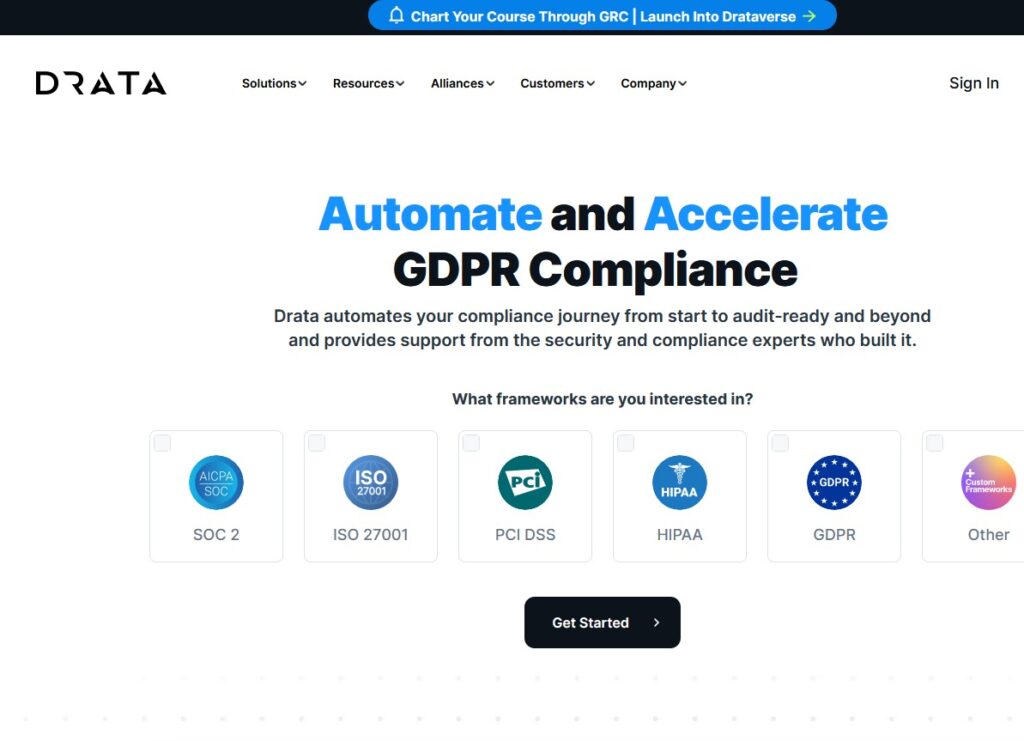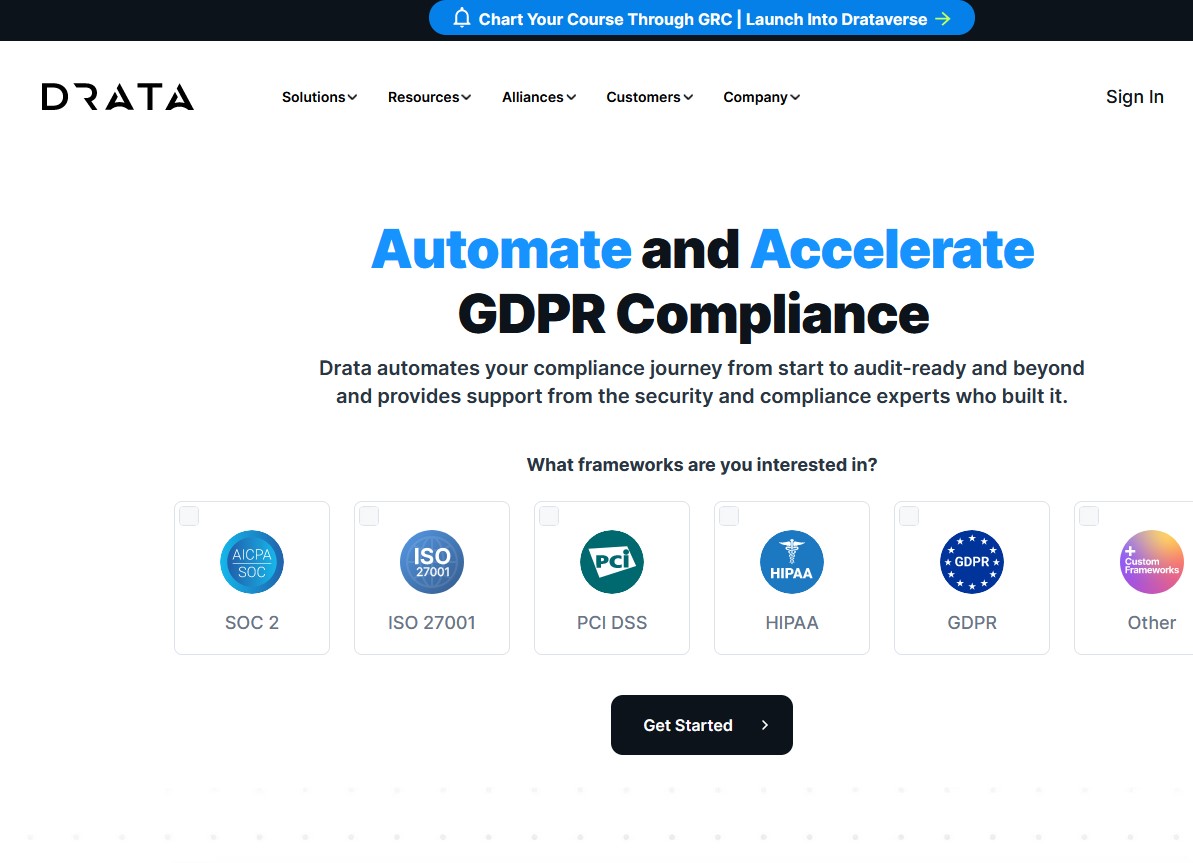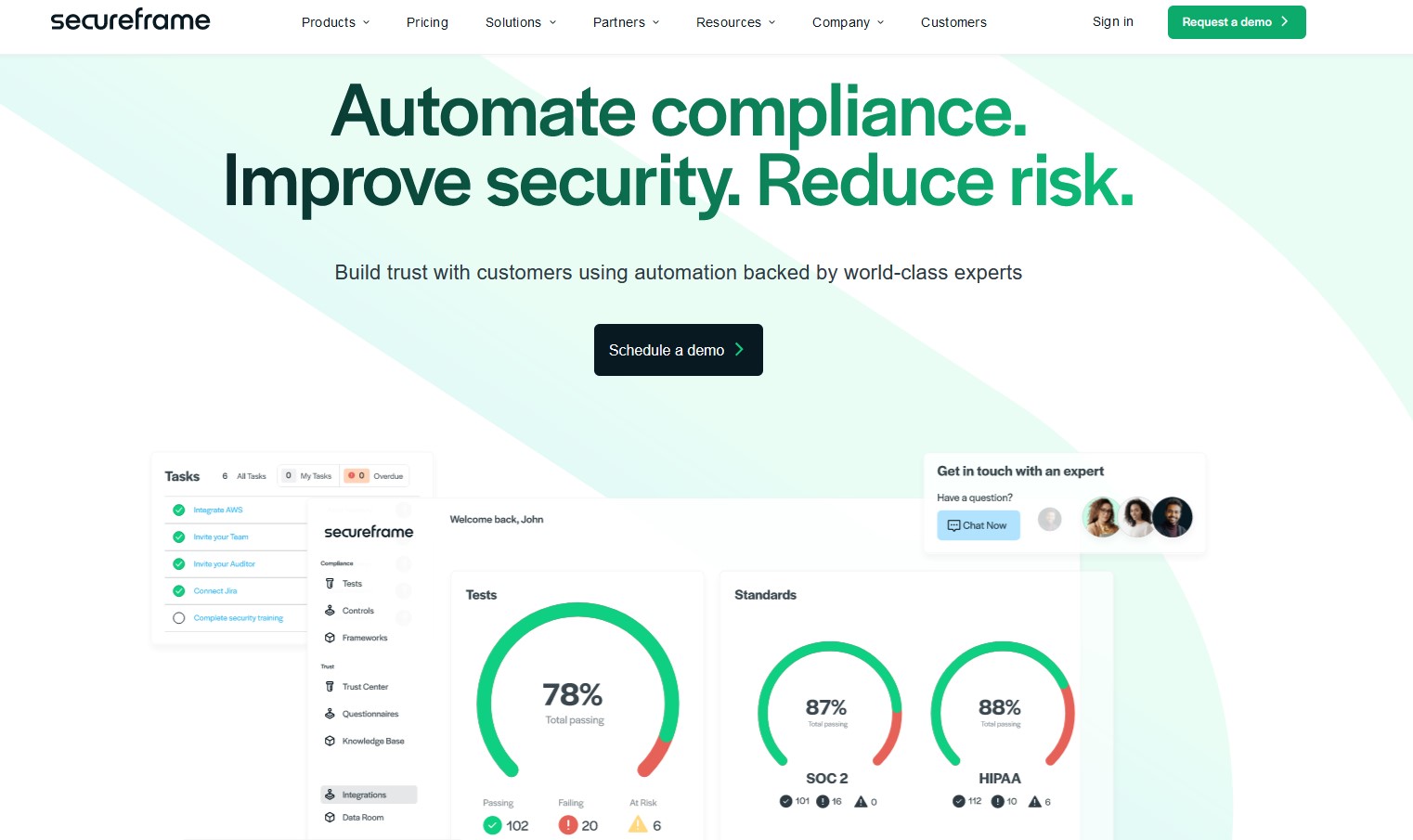Data security and regulatory compliance are paramount concerns for businesses that require compliance frameworks to operate day-to-day. As organizations navigate risk mitigation and data protection complexities, understanding the unique strengths of existing Governance, Risk and Compliance (GRC) solutions is crucial. The market for tools that facilitate compliance with regulations like HIPAA is intense. The largest players in terms of market share are Drata and Vanta, with Secureframe coming in a pretty distant (but still respectable) third.
We aim to use this article to shed light on key points of comparison between Drata and Secureframe’s Compliance Management System (CMS) offerings, focusing on integration capabilities, pricing models, and support services. Both platforms offer streamlined solutions for compliance process assessment, management, and continuous monitoring, catering to the evolving needs of modern organizations. This information could be helpful for businesses making decisions about their risk management strategies.
Criteria for Choosing a Compliance Management Tool:
- Level of automation: Evaluate how extensively each platform automates compliance tasks, as automation can significantly impact efficiency and resource allocation within your organization.
- Depth/functionality of integrations: Consider the breadth and functionality of integrations offered by Drata and Secureframe to ensure seamless compatibility with your existing tools and systems, enhancing overall workflow efficiency.
- Support quality: Assess the responsiveness, expertise, and availability of customer support services provided by both platforms, as reliable support is essential for addressing challenges and ensuring successful implementation.
- Pricing structure: Analyze the pricing models of Drata and Secureframe, including any additional fees or customization options, to determine the most cost-effective solution for your organization’s budget and compliance needs.
- Trust Center capabilities: For organizations focused on sales enablement and transparency, evaluate the Trust Center features offered by each platform, such as control sharing and policy documentation, to effectively demonstrate compliance to customers and stakeholders.
- Framework compatibility: Consider how well Drata and Secureframe align with your organization’s compliance objectives beyond SOC 2, ensuring compatibility with future regulatory frameworks or standards you may need to adhere to.
By carefully considering factors like these, organizations can make informed comparisons between Drata and Secureframe and choose the platform that best meets their compliance management requirements and long-term objectives.
Drata Overview (DEMO)
Drata is a leading provider of comprehensive compliance and risk management solutions, empowering medium and large startups, as well as established enterprises, to manage risks, maintain audit readiness, and achieve compliance milestones with confidence. Backed by a strong industry reputation and a commitment to unparalleled customer support, Drata is reshaping the compliance management landscape.
- Pricing: Ranges from $20,000 to $100,000, praised for fast implementation and comprehensive customer support.
- Integration and Scalability: Offers around 120 integrations, compensates for limited selection with robust scalability options.
- Vendor Reputation: Maintains a solid standing in compliance and risk management, known for quality support services.
Drata Key Features
Here are a list of Drata’s key features.
-
Comprehensive Compliance Monitoring
Drata’s robust monitoring capabilities ensure organizations remain audit-ready and proactive in risk management.
-
Pre-Canned Policies and Templates
The tool provides audit-friendly documentation with customizable templates, saving costs on technical writing reviews.
-
Structured Onboarding and Responsive Customer Support
Structured onboarding emphasizes fast and efficient implementation, with staged onboarding steps and 24/7 customer support.
-
Integration and Scalability
Offers flexibility and accommodates growth over time with integration capabilities with various tools and systems.
-
Customizable Trust Center
Tailors compliance solutions to specific needs, enhancing flexibility.
-
Centralized Document Management
Reduces clutter and improves accessibility with centralized document management, providing a clear roadmap for compliance progress.
Pros:
- Streamlined Implementation Process: Staged onboarding steps allow efficient setup.
- Audit-Friendly Templates: Pre-canned policies and templates save costs on technical writing reviews.
- Integrated Approach: Integration with SaaS ecosystems reduces operational time.
- Centralized Document Management: Improved accessibility for stakeholders with centralized document management.
- Clear Roadmap for Compliance Progress: Provides a clear path for organizations to track their compliance progress.
Cons:
- Limited Integrations: Fewer integrations with third-party tools compared to competitors like Vanta (Drata does have more integration capability than Secureframe)
- Visibility of Recurring Tasks: Improvement needed for enhanced task visibility.
- Complexity for New Users: Feature complexity may overwhelm new users.
- User-Friendly Improvements: The policy editor could be more intuitive.
- Configuration Limitations: The free trust center lacks configurability.
- Custom Framework Implementation: Requires significant effort and extra cost.
Drata Pricing
Drata’s pricing ranges from $20,000 to $100,000, depending on factors like company size and selected compliance framework. While it may be pricier than some competitors, Drata is praised for its fast implementation and comprehensive customer support.
Drata Integration and Scalability
Drata offers around 120 integrations, providing compatibility with existing IT infrastructure and enterprise systems. It compensates for limited integration selection with robust scalability options to accommodate growth and evolving compliance needs over time.
Target Audience
Drata is tailored for medium and large startups, large enterprises, and auditors committed to meeting compliance standards. It is ideal for organizations prioritizing security over cost within the realm of HIPAA compliance software. Additionally, it is suited for businesses aiming to enhance existing compliance frameworks effectively, regardless of their current compliance journey stage.
Vendor Reputation and Support
Drata maintains a solid standing in the compliance and risk management industry, known for quality support services and efficient technical assistance.
Secureframe Overview (DEMO)
Secureframe empowers businesses to navigate compliance challenges efficiently and effectively, providing a suite of comprehensive features and expert support. The tool allows for a 2-week free trial and demos for each product type and tier, allowing organizations to explore the tool’s capabilities before committing. Check out this detailed Plant Compliance review of Secureframe here.
- Pricing: Offers gap analysis with costs varying based on company size, plus annual subscription fees starting at $7,500 per framework activated.
- Integration and Scalability: Seamlessly integrates with over 200 cloud providers, ensuring comprehensive coverage for compliance and security needs.
- Vendor Reputation: Renowned for fast compliance timelines, comprehensive integrations, and high-quality support services.
Secureframe Key Features
Here is a list of the key features from Secureframe.
-
Automates Key Compliance Tasks
Automates key compliance tasks such as vendor security assessment, compliance management, and continuous monitoring, expediting the compliance process and minimizing manual effort.
-
Accelerates Compliance Timelines
Offers accelerated compliance timelines, reducing the time required to achieve SOC 2 and ISO 27001 compliance from months to weeks.
-
Seamless Integrations
Seamlessly integrates with over 200 cloud providers, essential platforms, and tools, enhancing overall efficiency and security coverage.
-
Continuous Monitoring
Continuous monitoring features ensure ongoing compliance by monitoring system controls and demonstrating commitment to data security.
-
Expert Support
Provides expert support throughout the compliance journey, offering personalized guidance and assistance tailored to each company’s unique requirements.
Pros:
- Offers a flexible pricing model tailored to specific security needs.
- Comprehensive features and seamless integrations enhance compliance efficiency.
- Accelerated compliance timeline reduces manual work, speeds up compliance process.
- Expert support from security professionals ensures personalized guidance.
- Prioritizes data security and privacy, offering robust encryption protocols.
Cons:
- May not offer as specialized options as some competitors, potentially limiting customization.
- Some users find the pricing structure could be more straightforward.
- Integration options, while extensive, may be fewer compared to some competitors.
- Interface may be less intuitive or user-friendly compared to other compliance tools.
Secureframe Pricing
Secureframe offers two main services: a thorough gap analysis, and subscription access to its compliance platform. Initial gap assessment cost varies based on company size, system complexity, and regulatory standards.
Annual subscription fees cover compliance monitoring, automated checks, and audit support, starting at $7,500 per framework activated, with an additional $7,500 annually for access for the first 100 employees.
Secureframe Integration and Scalability
Secureframe seamlessly integrates with over 200 cloud providers, essential platforms, and tools, streamlining evidence collection and policy implementation. While the platform’s integration options may be fewer compared to some competitors, its integrality and scalability ensure comprehensive coverage for compliance and security management needs across verticals.
Secureframe Target Audience
Secureframe tailors its compliance services to accommodate startups, medium-sized businesses, and large corporations alike. The tool places a strong emphasis on adhering to compliance standards such as SOC 2 and ISO 27001, positioning it as a comprehensive solution for organizations that prioritize the protection of data security and privacy.
Secureframe Vendor Reputation and Support
Renowned for its fast compliance timelines, comprehensive set of available integrations, and high-quality support services. Boasts a solid reputation in the industry, providing efficient technical assistance and timely updates, ensuring customer satisfaction.
On the negative side, Secureframe has a bit of a negative reputation for overpromising functionality in an effort to compete with Drata and Vanta, who are bigger, better-funded players in the GRC space.
Drata vs. Secureframe Head-to-Head
Drata and Secureframe provide cloud-based compliance management tools, simplifying the complex process of maintaining regulatory standards and data security. Both platforms explore and document compliance requirements, ensuring organizations remain audit-ready and proactive in risk management.
These services share many similarities in their approach to compliance management, making it challenging for organizations to choose between them. With a shared focus on thorough compliance monitoring and documentation, both Drata and Secureframe offer customizable templates and structured onboarding processes.
Drata vs. Secureframe: Head-to-Head Comparison
This section details how the two compliance platforms compare against each other.
Pricing:
– Drata: Ranges from $20,000 to $100,000.
– Secureframe: Offers gap analysis with costs varying based on company size, plus annual subscription fees starting at $7,500 per framework activated.
Integration and Scalability:
– Drata: Offers around 120 integrations and robust scalability options.
– Secureframe: Seamlessly integrates with over 200 cloud providers and ensures comprehensive coverage for compliance and security needs.
Vendor Reputation and Support:
– Drata: Maintains a solid standing in the compliance and risk management industry, known for quality support services and efficient technical assistance.
– Secureframe: Renowned for fast compliance timelines, comprehensive integrations, and high-quality support services. Secureframe has a tendency, according to users, to over-promise on functionality in order to compete with larger players.
Key Features comparison:
– Drata: Comprehensive compliance monitoring, pre-canned policies and templates, structured onboarding, and customizable trust center.
– Secureframe: Automated compliance tasks, accelerated compliance timelines, seamless integrations, continuous monitoring, and expert support.
Conclusion
Both Drata and Secureframe stand out as leading providers of compliance management solutions tailored to meet the diverse needs of businesses in today’s regulatory landscape. They excel in providing comprehensive compliance monitoring, audit-friendly documentation, and structured onboarding processes.
Drata and Secureframe each have their pros and cons, and organizations should carefully evaluate their requirements, budget constraints, and long-term goals before making a decision. With the right choice, businesses can ensure they have the tools and support they need to navigate the complexities of regulatory compliance and data security effectively.
Ultimately, the choice between Drata and Secureframe hinges on the specific needs and priorities of each organization. While both platforms offer powerful compliance management tools, Drata’s focus on integration and scalability may appeal to organizations looking for comprehensive solutions that can grow with their business.


